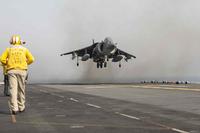At a recent conference here in Washington, D.C. on future defense strategy, Dakota Wood, a former Marine and one of the big brains over at the Center for Strategic and Budgetary Assessments, posed some provocative questions about correct force-sizing for the contemporary and future battlefield.
He argued in his presentation, and in a monograph titled The U.S. Marine Corps: Fleet Marine Forces for the 21st Century, that in a future filled with small wars where potential opponents are changing their organizational “building block” away from brigades and battalions to smaller, distributed units, then perhaps the U.S. military should follow suit.
There are indications that some states are disbanding heavy-armor units to create small anti-armor hunter-killer teams that adopt guerrilla style hit and run tactics, Wood said. The successes Chechen rebels had in their battles during the 1990s against Russian armored units and those of Hezbollah fighters in their clashes with Israeli ground forces in Lebanon in 2006 demonstrated the effectiveness of such units and tactics. Non-state and state supported fighters have ready access to affordable, advanced anti-armor and anti-air weaponry, night and thermal imaging devices and digital communications, making small units much more lethal. The increased lethality of modern weapons results in the need for greater dispersion.
A post I wrote a couple of weeks back about the Mumbai attacks referenced an article written by former Australian Army officer David Kilcullen, who advocated for numbers of small fire teams better suited for urban combat, generated lots of commentary over at sister site Defense Tech. An earlier story I wrote about the Army and FCS also led to a discussion on whether the brigade was the wrong unit of organization for irregular wars, and that perhaps the Army should drop an echelon down to the battalion as its building block versus the Brigade Combat Team.
Wood’s argument is aimed at the Marines, as he envisions the need for smaller – company, platoon enhanced squads – sized naval infantry units to go aboard the Navy’s Littoral Combat Ships, and other ships, that will operate in littoral waters or as distributed elements of the navy’s new maritime strategy that puts heavy emphasis on partnering with foreign nations. That would mean fewer battle groups steaming around together and more individual ships putting in at distant ports for humanitarian visits, carrying out training exercises with foreign ships and policing pirate infested waterways; hence the need for more, and smaller Marine units able to operate independently of a larger MAGTF.
Part of the discussion on correct force sizing is driven by the larger debate in military circles over the types of wars likely to be fought in the future: major combat operations against conventional opponents versus irregular warfare against an enemy organized more as a guerrilla type force. The Marine Corps is currently wrestling over the question of whether it should return to its small war roots or focus on fighting big battles and opposed amphibious assaults. The outcome of the debate has obvious implications in terms of what weapons the service ends up buying. Wood argues that one potential implication is that because of the demands placed on the skill, maturity and experience of small unit leaders, perhaps the Marines should consider assigning majors as company commanders and senior first lieutenants as platoon leaders.
Almost exclusively, operations in Iraq and Afghanistan are company, platoon and section commander’s battles. The point Kilcullen makes is that militaries must train and rehearse as they intend to fight: “in small, semi-autonomous combined arms teams.” Not only is the potential of facing an opponent who fights in small, distributed units driving training in that direction, but also the nature of the battlefield which is most frequently complex urban terrain. “The close battle in complex terrain is a decentralized phenomenon: a subaltern’s war that is built around small, mobile teams that need all arms representation at platoon or even section level,” Kilcullen writes in the pages of one of my favorite sources, the Australian Army Journal (see Vol. 1, No. 2).
Also writing in AAJ, Canadian Army Trevor Cadieu, provides an excellent lessons learned account (Vol. 5, No. 2) of his country’s experience using main battle tanks, in this case the Leopard 2, in operations against the Taliban in southern Afghanistan. That experience validated combined arms operations, but also demonstrated the importance of breaking up tank squadrons and distributing individual tanks among infantry sections. It should be noted that the U.S. Army has learned the same lesson in operations in Iraq.
Cadieu writes: “Gone are the days we must consider the smallest tactical grouping of armour to be the squadron. Fighting through urban areas and the dense vineyards of Afghanistan requires the decentralization of forces that are difficult to control at even the lowest tactical level. Exposed routinely to intense hostile fire from unknown sources, dismounted infantry troops often lack sufficient firepower to destroy well-protected and camouflaged enemy positions. Tanks provide the punch required for breaching structures and they were deployed specifically to increase the protection of our dismounted soldiers, even if that means the division of resources.”
All of which is to say that if the Army, and Marines, intend to “train as we fight,” companies and platoons must train to operate as independent units often far from higher echelon control or support from other friendly units. “The need for unit cohesion is the Achilles heel of the small fire team. When troops have not trained together, or are unused to rapid reorganization, battle groupings at too low a tactical level may simply damage unit cohesion and general morale,” Kilcullen writes.








